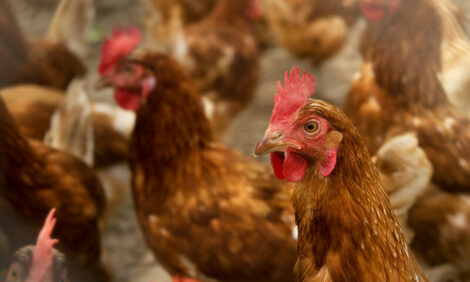



Industry Hopes for Better Times
US - Despite high feed costs and lower profits, recent improvements may signal the start of a turn-round for the poultry industry.After going through what some experts call the worst market in decades, poultry companies are hopeful their industry will rebound after a year of skyrocketing production costs and dwindling profits, according to Delmarva Now.
In the last two years, the national poultry market has encountered grain prices double their traditional average. The rising feed prices, combined with the glut of pork and beef and an oversupply of chicken meat, are the main ingredients in today's tight poultry market.
The result has been predictably bad, with many companies, such as Pilgrim's Pride and Tyson Foods, suffering heavy losses in the last fiscal quarter.
"We're in a perfect storm right now," said Jim Perdue, chairman of Perdue Farms.
However, he and other people in the industry feel the depressed market is showing signs of life.
Though still high, the price of soybeans and corn has dropped slightly in the last month. And the US Department of Agriculture also reported an 11 percent drop - year-to-year - in the number of chicken eggs in incubators last week, which would reduce the amount of chicken on the market and bring prices back up.
Still, industry analysts remain cautious about saying everything is OK now.
"If we get confirmation on the numbers (this) week, then we know it's real," said Paul Aho, a poultry industry expert in Connecticut.
The fluctuating cost of feed is at the heart of the poultry market's struggles.
According to Urner Barry, a commodity market news reporting service, a bushel of corn was selling at $4.38 last week, nearly a dollar cheaper than in September, but still higher than the $3.42 during the same time last year. Soybean meal has followed a similar trend, dropping to $271 per ton from last month's $341 per ton.
For poultry companies, which use about 100 million bushels of corn and soybeans a year, this has translated into hundreds of millions of dollars more in production costs. Tyson Foods in Arkansas reported a loss of $44 million in operating costs for its chicken production.
"Those costs have hurt us," Mr Perdue said. "Feed is two-thirds our cost for chickens. We live and die by our feeds."
He said those higher feed costs have hurt them and their fellow poultry companies on the back end as well.
"The chicken market has been depressed over the summer," he said. "Because they can't afford to feed them, people are putting beef and pork on the market sooner. If you look at all the featured advertising in the newspaper, what do you see? Beef and pork. And when people can buy a steak at half they could last year, they do."
Like every other business sector, the poultry industry has also suffered from the weak economy. Fewer people are eating out, which means lower demand from restaurants for chicken and everything else.
And people staying in to eat are making sure their groceries last longer.
"The economy is playing a part. Meat is a luxury," Dr Aho said. "People are stretching out their meat purchases."
Because consumers have made that choice, many poultry companies have paid the price.
Pilgrim's Pride, the nation's largest chicken processor, saw its stock tumble by 40 percent late last month when it reported major losses and the possibility of defaulting on its loans. The Pittsburg, Texas, company has since reached an agreement with its creditors and expects to make good on its loans into the end of the year.
Dr Aho said with other major companies such as Tyson taking losses, it is safe to say it has been a very bad stretch for the poultry industry.
"This is the worst episode we've seen in the chicken industry since the 1970s," he said.
Mr Perdue said the company has been able to insulate itself somewhat because of its diversity. Being one of the largest producers of grain in the country has helped.
"We've cut costs. In the food industry, it's good to be lean and mean, but we've had to become leaner and meaner," he said. "We've done cost reduction where we can, but there's nothing you can do about that."
Higher prices is something the company has also considered, Mr Perdue said, but that is just not feasible right now.
"We're tried to raise prices, but it's very difficult to raise prices when the market doesn't support it," he said.
With a tough summer behind them, industry officials said they are optimistic.
The USDA's report on egg reduction is one nugget in a possibility of a turnaround. The drop to nearly 189 million eggs in the week ending 11 October, compared to the eggs set in the same week last October, marked the lowest level in five years.
"We've been seeing about a 3 to 4 percent drop, but 3 percent isn't enough," Mr Perdue said.
Fewer eggs means less chicken on the market. And with the excess stock of beef drying up, chicken prices can return to being competitive in the meat market.
"This is very positive news for the industry and may signal that the industry is taking a more rationalized approach to production heading into the fall," Pilgrim's Pride spokesman, Gary Rhodes, said.
Mr Perdue is also optimistic. "In the first quarter 2009, I think we'll see a rise in prices and we'll be able to take advantage of it," he said.
Not that it will be easy. Perdue is braced to continue paying higher production costs, since it does not appear the price of feed is going to see any kind of major drop.
"We don't expect grain prices to go down," he said. "With one-third of the nation's corn going to ethanol plants, we don't expect that to change. We're in a new paradigm. Anything made from corn is going to go up in price."
However, Mr Perdue knows his company and the poultry industry will always have a place with consumers.
"I've always been glad to be in the food business," he told Delmarva Now. "People will still eat."











